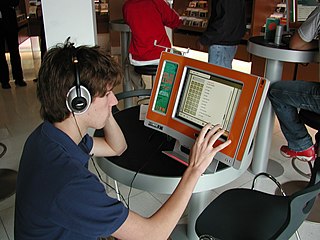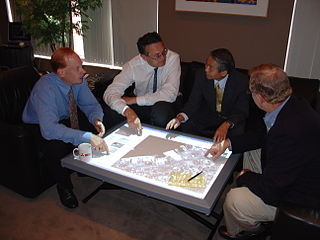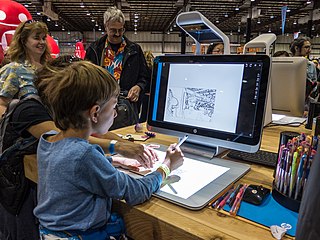Related Research Articles

A computer mouse is a hand-held pointing device that detects two-dimensional motion relative to a surface. This motion is typically translated into the motion of the pointer on a display, which allows a smooth control of the graphical user interface of a computer.

A pointing device is a human interface device that allows a user to input spatial data to a computer. CAD systems and graphical user interfaces (GUI) allow the user to control and provide data to the computer using physical gestures by moving a hand-held mouse or similar device across the surface of the physical desktop and activating switches on the mouse. Movements of the pointing device are echoed on the screen by movements of the pointer and other visual changes. Common gestures are point and click and drag and drop.

In 3D computer graphics, hidden-surface determination is the process of identifying what surfaces and parts of surfaces can be seen from a particular viewing angle. A hidden-surface determination algorithm is a solution to the visibility problem, which was one of the first major problems in the field of 3D computer graphics. The process of hidden-surface determination is sometimes called hiding, and such an algorithm is sometimes called a hider. When referring to line rendering it is known as hidden-line removal. Hidden-surface determination is necessary to render a scene correctly, so that one may not view features hidden behind the model itself, allowing only the naturally viewable portion of the graphic to be visible.

A touchscreen is a type of display that can detect touch input from a user. It consists of both an input device and an output device. The touch panel is typically layered on the top of the electronic visual display of a device. Touchscreens are commonly found in smartphones, tablets, laptops, and other electronic devices.

A tangible user interface (TUI) is a user interface in which a person interacts with digital information through the physical environment. The initial name was Graspable User Interface, which is no longer used. The purpose of TUI development is to empower collaboration, learning, and design by giving physical forms to digital information, thus taking advantage of the human ability to grasp and manipulate physical objects and materials.

In computing, multi-touch is technology that enables a surface to recognize the presence of more than one point of contact with the surface at the same time. The origins of multitouch began at CERN, MIT, University of Toronto, Carnegie Mellon University and Bell Labs in the 1970s. CERN started using multi-touch screens as early as 1976 for the controls of the Super Proton Synchrotron. Capacitive multi-touch displays were popularized by Apple's iPhone in 2007. Multi-touch may be used to implement additional functionality, such as pinch to zoom or to activate certain subroutines attached to predefined gestures using gesture recognition.
Perceptive Pixel is a division of Microsoft specializing in research, development and production of multi-touch interfaces. Its technology is used in fields including broadcast, defense, geo-intelligence, energy exploration, industrial design and medical imaging.

Pen computing refers to any computer user-interface using a pen or stylus and tablet, over input devices such as a keyboard or a mouse.
Microsoft PixelSense was an interactive surface computing platform that allowed one or more people to use and touch real-world objects, and share digital content at the same time. The PixelSense platform consists of software and hardware products that combine vision based multitouch PC hardware, 360-degree multiuser application design, and Windows software to create a natural user interface (NUI).
Surface computing is the use of a specialized computer GUI in which traditional GUI elements are replaced by intuitive, everyday objects. Instead of a keyboard and mouse, the user interacts with a surface. Typically the surface is a touch-sensitive screen, though other surface types like non-flat three-dimensional objects have been implemented as well. It has been said that this more closely replicates the familiar hands-on experience of everyday object manipulation.
In computing, 3D interaction is a form of human-machine interaction where users are able to move and perform interaction in 3D space. Both human and machine process information where the physical position of elements in the 3D space is relevant.
In computing, a natural user interface (NUI) or natural interface is a user interface that is effectively invisible, and remains invisible as the user continuously learns increasingly complex interactions. The word "natural" is used because most computer interfaces use artificial control devices whose operation has to be learned. Examples include voice assistants, such as Alexa and Siri, touch and multitouch interactions on today's mobile phones and tablets, but also touch interfaces invisibly integrated into the textiles furnitures.

In computing, an input device is a piece of equipment used to provide data and control signals to an information processing system, such as a computer or information appliance. Examples of input devices include keyboards, computer mice, scanners, cameras, joysticks, and microphones.

The DiamondTouch table is a multi-touch, interactive PC interface product from Circle Twelve Inc. It is a human interface device that has the capability of allowing multiple people to interact simultaneously while identifying which person is touching where. The technology was originally developed at Mitsubishi Electric Research Laboratories (MERL) in 2001 and later licensed to Circle Twelve Inc in 2008. The DiamondTouch table is used to facilitate face-to-face collaboration, brainstorming, and decision-making, and users include construction management company Parsons Brinckerhoff, the Methodist Hospital, and the US National Geospatial-Intelligence Agency (NGA).

Mobile technology is the technology used for cellular communication. Mobile technology has evolved rapidly over the past few years. Since the start of this millennium, a standard mobile device has gone from being no more than a simple two-way pager to being a mobile phone, GPS navigation device, an embedded web browser and instant messaging client, and a handheld gaming console. Many experts believe that the future of computer technology rests in mobile computing with wireless networking. Mobile computing by way of tablet computers is becoming more popular. Tablets are available on the 3G and 4G networks.

Microsoft Tablet PC is a term coined by Microsoft for tablet computers conforming to a set of specifications announced in 2001 by Microsoft, for a pen-enabled personal computer, conforming to hardware specifications devised by Microsoft and running a licensed copy of Windows XP Tablet PC Edition operating system or a derivative thereof.

Screen-Smart Device Interaction (SSI) is fairly new technology developed as a sub-branch of Digital Signage.

Sprout by HP was a personal computer from HP Inc. announced on October 29, 2014 and released for sale on November 9, 2014. The system was conceived by Brad Short, Distinguished Technologist at HP Inc., who along with Louis Kim, Head of the Immersive Computing Group at HP Inc., co-founded and led a team within HP Inc. to develop and productize the computing concept.

The Surface Hub is a brand of interactive whiteboard developed and marketed by Microsoft, as part of the Microsoft Surface family. The Surface Hub is a wall-mounted or roller-stand-mounted device with either a 55-inch (140 cm) 1080p or an 84-inch (210 cm) 4K 120 Hz touchscreen with multi-touch and multi-pen capabilities, running the Windows 10 operating system. The devices are targeted for businesses to use while collaborating and videoconferencing.
The Surface Book 3 is the third generation of Microsoft's Surface Book series, and a successor to the Surface Book 2. Like its previous generation, the Surface Book 3 is part of the Microsoft Surface lineup of personal computers. It is a 2-in-1 PC that can be used like a conventional laptop, or detached from its base for use as a separate tablet, with touch and stylus input support in both scenarios. It was announced by Microsoft online alongside the Surface Go 2 on May 6, 2020, and later released for purchase on May 12, 2020.
References
- ↑ Grossman, Lev (14 June 2007). "Feeling out the Newest Touch Screens". TIME. Archived from the original on June 18, 2007. Retrieved 2007-06-16.
- ↑ "Microsoft Launches New Product Category: Surface Computing Comes to Life in Restaurants, Hotels, Retail Locations and Casino Resorts". Microsoft. 29 May 2007. Retrieved 2007-06-16.
- ↑ Jeff Han